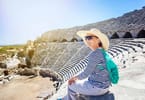Egypt’s chief archaeologist has announced the discovery of a 4,300-year-old pyramid in Saqqara, the sprawling necropolis and burial site of the rulers of ancient Memphis. The pyramid is said to belong to Queen Sesheshet, the mother of King Teti, first king and founder of the 6th Dynasty of Egypt’s Old Kingdom.
Dr. Zahi Hawass, secretary general of the Supreme Council of Antiquities, announced this week he and his team discovered the pyramid of the queen in Saqqara. He said the pyramid, which dates to over four millennia ago, is five meters high, although it must have been about 14 meters originally. The base is square – each side with a length of 22 meters. The sides of the pyramid sloped at an angle of 51 degrees, and the entire monument was originally covered in a casing of fine white limestone from Tura.
Within the last twenty years of excavation in the area, Hawass told eTN: “This is an important find. This is the 4th pyramid I have found in my career as Egyptologist after three in Saqqara and one next to the Great Pyramid in Giza. Sesheshet’s pyramid was buried under 60 feet of sand. I also found a part of the casing of the pyramid which measures three meters in length. If we were to reconstruct this pyramid, it will be quite tall.”
The pyramid whose architecture is characteristic of Dynasties 5 and 6 belonged to a queen named Sesheshet. “We are familiar with this queen from a mention of her in a medical papyrus containing a recipe, supposedly created at her request, for a preparation to strengthen the hair,” he said adding there are store items she were to use in the Afterlife.
“It’s unique and in very good shape. We have not entered the burial chamber yet, however, we hope to get in within a couple of days,” he said. Asked what he expects to see, Hawass said he hopes to see the sarcophagus and some inscriptions.
In the area surrounding the pyramid, Hawass’ team also found funerary figurines that date back to the 3rd Intermediate Period (818-712 BC), along with a New Kingdom chapel (ca. 1550 BC) decorated with a scene of the deceased offering to Osiris. Other finds from the area include a group of Late Period (399-343 BC) coffins, a wooden statue of the god Anubis, amulets, and a symbolic vessel in the shape of a cartouche, which still contained the remains of a green substance. These finds demonstrate that the entire area of the Old Kingdom’s Teti cemetery was re-used from the New Kingdom (1550 – 1295 BC) through the Roman Period (30 BC – 364 AD).
Near the newly discovered pyramid, Hawass and his Egyptian team had previously re-discovered the pyramid of Queen Khuit, the wife of King Teti. Scholars had long believed that Khuit was a second wife, but SCA’s important work proved that her pyramid was built before that of Iput I, previously believed to have been Teti’s chief queen. The fact that her pyramid was built before Iput’s however tells us that Khuit was in fact the primary royal wife. Previous work at this site, where Hawass has been excavating since he served as director of Giza and Saqqara, has also revealed the funerary temple of Khuit, offering much new information about the decorative programs of queens’ monuments of the period.
The archaeologist stated that the discovery of the pyramid of Sesheshet will further enrich our understanding of the pyramids of Dynasty 6 of the Old Kingdom.
There seems to be no end to all the treasures coming out of the Egyptian sands. As Hawass puts it: “As I have told you, we have dug up only 30 percent. There’s a lot more buried under the ground.” Currently, Hawass is working on four major missions – between Giza, Saqqara and Luxor’s Valley of the Kings. He told eTN, following yesterday’s major announcement, he’s now putting all his energy in his search for Cleopatra and Mark Anthony’s remains in a temple near Alexandria.
QUE RETENIR DE CET ARTICLE :
- Other finds from the area include a group of Late Period (399-343 BC) coffins, a wooden statue of the god Anubis, amulets, and a symbolic vessel in the shape of a cartouche, which still contained the remains of a green substance.
- “We are familiar with this queen from a mention of her in a medical papyrus containing a recipe, supposedly created at her request, for a preparation to strengthen the hair,”.
- This is the 4th pyramid I have found in my career as Egyptologist after three in Saqqara and one next to the Great Pyramid in Giza.






















